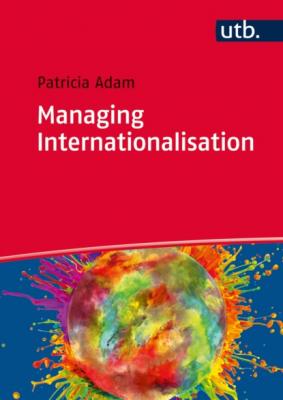Managing Internationalisation. Patricia Adam
Читать онлайн.| Название | Managing Internationalisation |
|---|---|
| Автор произведения | Patricia Adam |
| Жанр | Зарубежная деловая литература |
| Серия | |
| Издательство | Зарубежная деловая литература |
| Год выпуска | 0 |
| isbn | 9783846386163 |
Figure 1-14: The EFQM RADAR® Logic35
VIPs
| 1.4 | Process Model “Managing Internationalisation” |
Figure 1-15: The Internationalisation Process
The management logic of the EFQM Excellence Model can be used to define the path through the internationalisation process, as shown in Figure 1-15. The management process itself starts with leadership awareness and competence to steer the organisation through the internationalisation process. This is followed by the definition of an international strategy which sets the path for the following implementation. The strategy is implemented through the following steps: managing people in an international environment, managing international partners and resources as well as managing products and processes globally. Based on a sustainability approach the results achieved will be compared with the (strategic) goals set, defined by ways of an individual balanced scorecard. A strategy review based on the outcomes will follow to ensure that the longterm vision of the company is still valid and the path to be followed seen as appropriate. These internationalisation steps are supported by the development of crosscultural competence, which is required for every action and decision in internationally operating organisations. Therefore it defines the starting point for the following elaborations of this book.
| 1.5 | Citations & Notes |
1 Morschett, D., Schramm-Klein, H., & Zentes J. (2010), pp. 71-82; Holtbrügge, D., & Welge, M. K. (2010), pp. 25-26.
2 Contents based on Morschett, D., Schramm-Klein, H., & Zentes J. (2010), p. 72, figure 4.1; Holtbrügge, D., & Welge, M. K. (2010), p. 24, tab. 1-7
3 Johanson, J., & Vahlne, J.-E. (1977)
4 A good overview of theories dealing with foreign direct investments is provided in Holtbrügge, D., & Welge, M. K. (2010), pp. 54-78
5 UNCTAD (2013b)
6 UNCTAD (2010), p. iii
7 UNCTAD (2010), p. XVIII. Unfortunately, the newer World Investment Reports concentrate on FDI inflows and outflows but do not offer a recent count of TNCs.
8 UNCTAD (2014), p. 16
9 Bartlett, C., & Ghoshal, S. (1986); Bartlett, C., & Ghoshal, S. (1987a); Bartlett, C., & Ghoshal, S. (1987b); Ghoshal, S., & Nohria, N. (1993); Bartlett, C., & Ghoshal, S. (1998)
10 Based on Bartlett, C., & Ghoshal, S. (1986), p. 377; Kutschker, M., & Schmid, S. (2011), p. 300
11 Bartlett, C., & Ghoshal, S. (1986); Bartlett, C., & Ghoshal, S. (1987a); Bartlett, C., & Ghoshal, S. (1987b); Ghoshal, S., & Nohria, N. (1993); Bartlett, C., & Ghoshal, S. (1998). Industry examples from Morschett, D., Schramm-Klein, H., & Zentes J. (2010), pp. 43-44 and Kutschker, M., & Schmid, S. (2011), pp.301-304.
12 Bartlett, C., & Ghoshal, S. (1998), p. 18
13 Bartlett, C., & Ghoshal, S. (1986); Bartlett, C., & Ghoshal, S. (1987a); Bartlett, C., & Ghoshal, S. (1987b); Ghoshal, S., & Nohria, N. (1993); Bartlett, C., & Ghoshal, S. (1998); Morschett, D., Schramm-Klein, H., & Zentes J. (2010), pp. 34-35; Kutschker, M., & Schmid, S. (2011), pp.301-304.
14 Economist Intelligence Unit (2012)
15 Rüegg-Stürm, J. (2004a), p. 12
16 Rüegg-Stürm, J. (2004b). More information about the use of this integrative approach can be obtained at the website of Universität St. Gallen: http://www.es.unisg.ch/en/custom-programs/approach/intergrative-approach.php (access 01.03.2015); A good overview offers the author’s German publication (Rüegg-Stürm, J. (2004a)). An extract of it is obtainable online: http://www.michaelegli.ch/html/img/pool/Neues_St._Galler_Managementmodell.pdf (retrieved 01.03.2015).
17 US Department of Commerce & NIST (2015). The model will be updated yearly and the recent brochures are for sale and partly displayed at the NIST website. Information about the use of this model for awards in different countries can be obtained from US Department of Commerce & NIST (2005). As “Home of the Baldrige Performance Excellence Program” the NIST offers also many publications of MBNQA winners with best practices free of charge, true to their mission to foster improvements.
18 US Department of Commerce & NIST (2015); graphics also available from http://www.nist.gov/baldrige/graphics.cfm
19 US Department of Commerce & NIST (2015); graphics also available from http://www.nist.gov/baldrige/graphics.cfm
20 NIST (2010)
21 EFQM & ILEP (2012). A short introduction to the EFQM itself, the EFQM model, its Fundamental Concepts and possible uses can be retrieved from the official EFQM website (www.efqm.org). A short overview of the model is offered as pdf publication free of charge: EFQM. (2012). An overview of the EFQM Excellence Model. Retrieved from www.efqm.org/sites/default/files/overview_efqm_2013_v1.1.pdf. The EFQM offers at its website model related publications in several languages, mainly for sale. For German users that work internationally, the dual language version (German/English) used here can be highly recommended. For some award processes, free information on best practices concerning selfassessments and the award process is provided on the internet. For example for the German Excellence Price called Ludwig-Erhard-Preis (www.ilep.de)
22 EFQM (2015d)
23 EFQM (2015e)
24 EFQM (2015f)
25 NIST (2010)
26 EFQM & ILEP (2012), p. 6
27 Definitions taken from EFQM & ILEP (2012), pp. 8-14
28 EFQM & ILEP (2012), p. 16
29 Definitions assembled from EFQM & ILEP (2012), pp. 18-31
30
